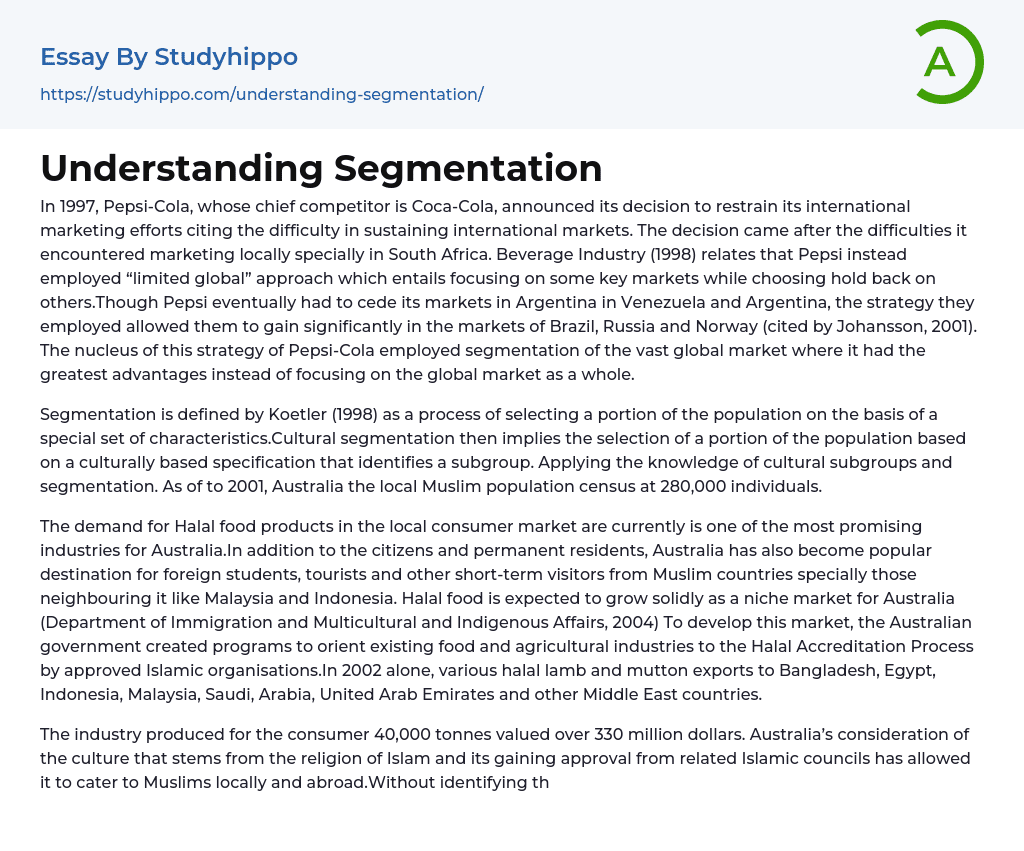Pepsi-Cola, a competitor of Coca-Cola, made an announcement in 1997. They stated that they would reduce their international marketing activities because it was challenging to maintain markets abroad. This decision was prompted by difficulties faced in local marketing, specifically in South Africa. According to Beverage Industry (1998), Pepsi chose a "limited global" approach instead, concentrating on important markets while being cautious with others. Although Pepsi had to ultimately exit markets in Venezuela and Argentina, this strategy resulted in notable successes in Brazil, Russia, and Norway (as cited by Johansson, 2001).
The main strategy of Pepsi-Cola was to focus on segmenting the global market by utilizing its unique advantages instead of targeting the entire global market. Koetler (1998) defines segmentation as the process of selecting a specific portion of the population based on certain characteristics. Cultural segmentation, in this case, involves selecting a sub
...group of the population based on cultural specifications. Pepsi-Cola aimed to effectively target specific consumer groups by understanding cultural subgroups and implementing segmentation. The Muslim population in Australia was estimated at 280,000 individuals in 2001.
Australia's Halal food industry is experiencing strong growth in the local consumer market. The country has become a popular choice for foreign students, tourists, and short-term visitors from Muslim countries like Malaysia and Indonesia (Department of Immigration and Multicultural and Indigenous Affairs, 2004). The Australian government has implemented programs to help existing food and agricultural industries obtain Halal accreditation from approved Islamic organizations. In 2002 alone, Australia exported over 40,000 tonnes of Halal lamb and mutton valued at over 330 million dollars to Bangladesh, Egypt, Indonesia, Malaysia, Saudi Arabia, United Arab Emirates, and other Middle East countries. Australia's efforts t
accommodate Islamic culture have allowed it to serve both domestic and international Muslim consumers. By identifying the specific needs of this market segment and implementing corresponding programs, Australia has established itself as a leader in the Halal food industry.
When Richard Ash became the General Manager of Macquarie Bank's China Housing Investment Funds, he learned about the importance of owning a house in China to attract a partner due to the gender imbalance. This sparked Macquarie Bank's interest in the Chinese housing market. The decision to target China was influenced by the company's prior experience in dealing with Chinese customers. One aspect they deemed crucial for success in China was improving brand recognition. Macquarie Bank sought to leverage its successful investment track record in Australia and established relationships with investors. In order to secure funding for its operations, Macquarie Bank planned to diversify its capital sources by using a combination of currencies, prioritizing Australian investment followed by contributions from Asia, the USA, and Europe.
The "China Housing Investment Fund" (CHIF) required a minimum investment of $US 500,000 to attract potential investors. To establish trust and gain confidence, it was essential to involve individuals who were familiar with Chinese business culture and the services that were crucial in this market. Recognizing the language barriers, Macquarie employed various strategies. Extensive newspaper advertisements were published in both English and Chinese newspapers, English and Chinese Memorandum were prepared and circulated, and seminars were organized for potential Chinese investors (Department of Immigration and Multicultural and Indigenous Affairs, 2002). The success of this approach can be seen in the investor composition, with approximately 60% Australian investors, 30% Asian investors, and 10% American investors
by 1998. These numbers surpassed company targets despite the Asian Economic Crisis of the 90s.
- Australian Culture essays
- Investing essays
- Asset essays
- Depreciation essays
- Discounted Cash Flow essays
- Foreign Direct Investment essays
- Funds essays
- Internal Rate Of Return essays
- Revenue essays
- Day Trading essays
- Futures Trading essays
- Capital market essays
- Million essays
- Payment essays
- Rate Of Return essays
- Funding essays
- Hedge Fund essays
- Afghanistan essays
- Africa essays
- America essays
- Asia essays
- Australia essays
- Caribbean essays
- City essays
- Developing Country essays
- Dubai essays
- Earthquake essays
- Europe essays
- Fracking essays
- Georgia essays
- Middle East essays
- Natural Disaster essays
- New Zealand essays
- North Korea essays
- South Korea essays
- Thailand essays
- Travel essays
- Bank essays
- Banking essays
- Corporate Finance essays
- Credit Card essays
- Currency essays
- Debt essays
- Donation essays
- Enron Scandal essays
- Equity essays
- Financial Accounting essays
- Financial Crisis essays
- Financial News essays
- Financial Ratios essays




